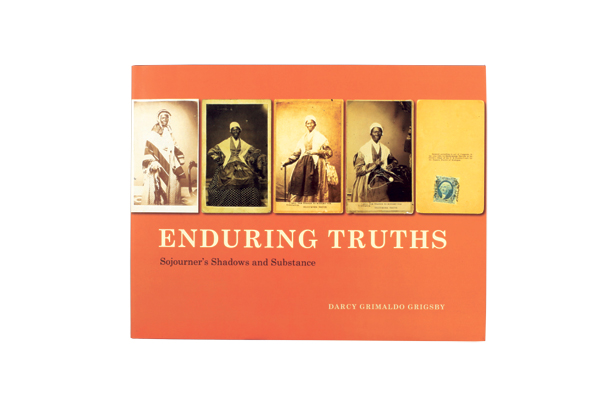Vicki Goldberg on Darcy Grimaldo Grigsby, Enduring Truths: Sojourner’s Shadows and Substance
In 1826, a thirty-year-old slave named Isabella Baumfree escaped from captivity, taking her baby with her but leaving behind her husband and three other children. She would become someone else: legally free, an outspoken and effective supporter of the abolitionist cause, and a woman who fully understood and astutely utilized the rising power of photography and of the press. Although she was and remained illiterate, she was also a much-published writer and sought-after lecturer. Changing her name to go with her changed circumstances, she entered history as Sojourner Truth.
Darcy Grimaldo Grimsby’s Enduring Truths: Sojourner’s Shadows and Substance is an admirable and admirably expansive scholarly enterprise that tracks down twenty-eight different photographic portraits Sojourner sat for, which she had reprinted multiple times and sold (for 25 to 40 cents apiece) to support her lectures and her life. Grigsby also teases out the message Truth meant to convey, then fills in a fascinating history on the uses and impact of photographs on abolitionism and the post–Civil War era.

Assisted by friends and relatives, Truth wrote innumerable letters to newspapers, asking that they be published. That an illiterate ex-slave in the mid-to-late nineteenth century should have had such a clear, such a modern, understanding of the persuasive (and propagandist) power of both photographs and the press is a fact to be engraved upon the mind. This book should be read in tandem with John Stauffer, Zoe Trodd, and Celeste-Marie Bernier’s Picturing Frederick Douglass (Liveright, 2015), discussed in the Spring 2016 issue of Aperture magazine, “Vision & Justice.” Together, these two books generously enlarge the story of photographic and racial history in this country. (Full disclosure: John Stauffer is a friend, but anyone should find this book remarkable.)
Truth was an activist; she lectured and wrote on behalf of abolition and, during the war, on its behalf as well, for she believed it was being fought to abolish slavery. When her grandson enlisted in a colored regiment, she posed for portraits with his framed photograph on her lap—until he was captured, which often meant death at Confederate hands. The photograph within the photograph indicated a direct contribution to the cause, the closest a woman could come to actual soldiering. After his disappearance, Truth posed with her knitting, another sign of patriotism, as women knitted to keep soldiers warm. She also taught knitting to black women to give the unskilled a skill—slaves did not knit. Always she presented herself as a respectable, intelligent woman, far removed, and properly so, from the imagery of slavery.
Truth’s photographs were mostly cartes de visite, cheap and easily disseminated through the recently reformed post. (How apt that she named herself Truth at a time when photographs were thought to be truth incarnate.) Cartes de visite, which had been crucial to Lincoln’s first election and were key elements in the first celebrity craze (as discussed in my 1991 book The Power of Photography), were the first mass-produced photographs. Truth copyrighted hers and added the text: “I Sell the Shadow to Support the Substance.” Like many an entrepreneur, she ran her sales as a private business. She also made extensive use of the nascent mass media, the newspapers and journals that proliferated in the North.
Her portraits (and Douglass’s) were civil rights photographs: some to propagandize for the Civil War, all to announce that black Americans deserved the same respect that whites did. Photographs have continued to contribute heavily to that cause. In the 1960s, pictures of fire hoses and dogs loosed on black Americans helped spur government action, and more recent smartphone and police body-cam videos of police action against black people have ignited peaceful protests, riots, dismissals, trials, and investigations. Enduring Truths illuminates the resourcefulness and importance of one woman at an early stage of this struggle, limns a detailed map of her sojourn, and underlines the vital role photography has played from the moment when technologies, history, and social change first put it on center stage.
VICKI GOLDBERG’s forthcoming bio of Bruce Davidson, part of a series on Magnum photographers, will be released this spring as Bruce Davidson: Magnum Legacy (Prestel, 2016).
Darcy Grimaldo Grigsby
Enduring Truths: Sojourner’s Shadows and Substance
University of Chicago Press • Chicago, 2015 • Designed by Ryan Li
10 7/8 x 8 1/2 in. (27.6 x 21.6 cm) • 240 pages
156 black-and-white and color images
Hardcover with jacket • press.uchicago.edu























